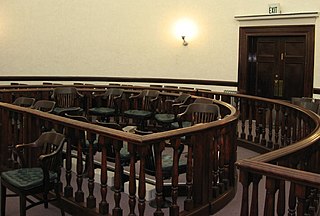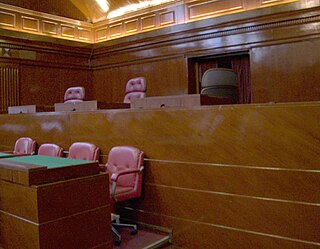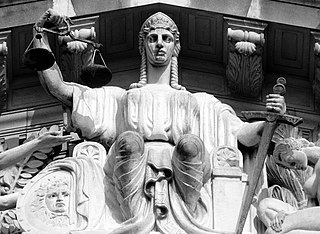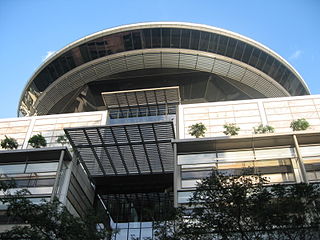
A jury is a sworn body of people (jurors) convened to hear evidence, make findings of fact, and render an impartial verdict officially submitted to them by a court, or to set a penalty or judgment. Most trial juries are "petit juries", and usually consist of twelve people. A larger jury known as a grand jury has been used to investigate potential crimes and render indictments against suspects.

In English law, natural justice is technical terminology for the rule against bias and the right to a fair hearing. While the term natural justice is often retained as a general concept, it has largely been replaced and extended by the general "duty to act fairly".
Batson v. Kentucky, 476 U.S. 79 (1986), was a landmark decision of the United States Supreme Court ruling that a prosecutor's use of a peremptory challenge in a criminal case—the dismissal of jurors without stating a valid cause for doing so—may not be used to exclude jurors based solely on their race. The Court ruled that this practice violated the Equal Protection Clause of the Fourteenth Amendment. The case gave rise to the term Batson challenge, an objection to a peremptory challenge based on the standard established by the Supreme Court's decision in this case. Subsequent jurisprudence has resulted in the extension of Batson to civil cases and cases where jurors are excluded on the basis of sex.
The separation of powers in Australia is the division of the institutions of the Australian government into legislative, executive and judicial branches. This concept is where legislature makes the laws, the executive put the laws into operation, and the judiciary interprets the laws; all independently of each other. The term, and its occurrence in Australia, is due to the text and structure of the Australian Constitution, which derives its influences from democratic concepts embedded in the Westminster system, the doctrine of "responsible government" and the United States version of the separation of powers. However, due to the conventions of the Westminster system, a strict separation of powers is not always evident in the Australian political system, with little separation between the executive and the legislature, with the executive required to be drawn from, and maintain the confidence of, the legislature; a fusion.
Recusal is the legal process by which a judge, juror, or other adjudicator steps aside from participating in a case due to potential bias, conflict of interest, or appearance of impropriety. This practice is fundamental to ensuring fairness and impartiality in legal proceedings, preserving the integrity of the judiciary, and maintaining public confidence in the legal system. Historical and modern legal frameworks outline specific grounds for recusal, such as personal or financial conflicts of interest, prior involvement in a case, or demonstrated bias. Applicable statutes or canons of ethics may provide standards for recusal in a given proceeding or matter. Providing that the judge or decision-maker must be free from disabling conflicts of interest makes the fairness of the proceedings less likely to be questioned, and more likely that there is due process.
In Canadian law, a reasonable apprehension of bias is a legal standard for disqualifying judges and administrative decision-makers for bias. Bias of the decision-maker can be real or merely perceived.
The Canadian Forces Drug Control Program is a series of regulations established in 1992 to prevent drug use among members of the Canadian Forces (CF), under the broad regulation-making auspices of section 12 of the National Defence Act (NDA). It prohibits CF members from involvement with most drugs, except alcohol and tobacco, purportedly to maintain discipline within the CF, ensure the safety, reliability or health of CF members. Chapter 20 of Queen's Regulations and Orders contains several schemes for drug-testing such as safety-sensitive testing, blind testing, and testing for suspicion under the article for "testing for cause." The regulation enforces administrative and disciplinary action against those who transgress its requirements.
Irvin v. Dowd, 359 U.S. 394 (1959), was a United States Supreme Court case. It involved the denial of appeal of an escaped convict, Leslie Irvin. The convict sought a federal writ of habeas corpus.
Caperton v. A. T. Massey Coal Co., 556 U.S. 868 (2009), is a case in which the United States Supreme Court held that the Due Process Clause of the Fourteenth Amendment requires judges to recuse themselves not only when actual bias has been demonstrated or when the judge has an economic interest in the outcome of the case but also when "extreme facts" create a "probability of bias."

In Singapore, the offence of scandalizing the court is committed when a person performs any act or publishes any writing that is calculated to bring a court or a judge of the court into contempt, or to lower their authority. An act or statement that alleges bias, lack of impartiality, impropriety or any wrongdoing concerning a judge in the exercise of his judicial function falls within the offence. The High Court and the Court of Appeal are empowered by section 7(1) of the Supreme Court of Judicature Act to punish for contempt of court. This provision is statutory recognition of the superior courts' inherent jurisdiction to uphold the proper administration of justice. The Subordinate Courts are also empowered by statute to punish acts of contempt. Although Article 14(1)(a) of the Constitution of the Republic of Singapore protects every citizen's right to freedom of speech and expression, the High Court has held that the offence of scandalizing the court falls within the category of exceptions from the right to free speech expressly stipulated in Article 14(2)(a). Some commentators have expressed the view that the courts have placed excessive value on protecting the independence of the judiciary, and have given insufficient weight to free speech.

Bias is one of the grounds of judicial review in Singapore administrative law which a person can rely upon to challenge the judgment of a court or tribunal, or a public authority's action or decision. There are three forms of bias, namely, actual, imputed and apparent bias.
Ham v. South Carolina, 409 U.S. 524 (1973), was a United States Supreme Court decision concerning examinations of prospective jurors during voir dire. The Court held that the trial court's failure to "have the jurors interrogated on the issue of racial bias" violated the petitioner's due process right under the Fourteenth Amendment. This right does not extend to any question of bias, but it does not preclude questions of relevant biases.

Procedural impropriety in Singapore administrative law is one of the three broad categories of judicial review, the other two being illegality and irrationality. A public authority commits procedural impropriety if it fails to properly observe either statutory procedural requirements, or common law rules of natural justice and fairness.

Re Shankar Alan s/o Anant Kulkarni was a 2006 administrative law judgment in which the High Court of Singapore quashed a decision made by the Disciplinary Committee of the Law Society of Singapore against a lawyer, Alan Shankar s/o Anant Kulkarni. The Disciplinary Committee had found Shankar, who was a solicitor, guilty of grossly improper misconduct under the Legal Profession Act. Shankar applied to the High Court for judicial review on the ground that the Committee's ruling was affected by apparent bias.

Citco Banking Corporation NV v Pusser's Ltd[2007] UKPC 13 is a judicial decision of the Privy Council on appeal from the British Virgin Islands in relation to the validity of amendments to the memorandum and articles of association of a company, and the requirement of shareholders to exercise the votes attached to their shares in the best interests of the company as a whole.
Judicial independence is regarded as one of the foundation values of the Australian legal system, such that the High Court held in 2004 that a court capable of exercising federal judicial power must be, and must appear to be, an independent and impartial tribunal. Former Chief Justice Gerard Brennan described judicial independence as existing "to serve and protect not the governors but the governed", albeit one that "rests on the calibre and the character of the judges themselves". Despite general agreement as to its importance and common acceptance of some elements, there is no agreement as to each of the elements of judicial independence.

Kelly v Trinity College Dublin[2007] IESC 61; [2007] 12 JIC 1411; is an Irish Supreme Court case in which the Court held that former employments or associations are insufficient, in the absence of other evidence, to disqualify a person from participating in disciplinary or similar tribunals related to that former employment.

Bula Ltd v Tara Mines Ltd [2000] IESC 15; [2000] 4 IR 412 is a reported Irish Supreme Court case in which the court considered the test for objective bias in Ireland. During this case the Supreme Court considered:
- whether Supreme Court has jurisdiction to set aside its own previous order;
- whether an appellant must show real likelihood of bias or whether reasonable apprehension of bias suffices; and
- whether a prior relationship of legal advisor and client would disqualify a judge.
Corrine Sparks is a Canadian judge. She was the first Black Canadian woman to become a judge in Canada, and the first black judge in the province of Nova Scotia. Her decision in the case R v S (RD), which was controversially overturned on appeal, was later upheld by the Supreme Court of Canada in a leading decision on reasonable apprehension of bias.

Fox v Percy is a decision of the High Court of Australia.










